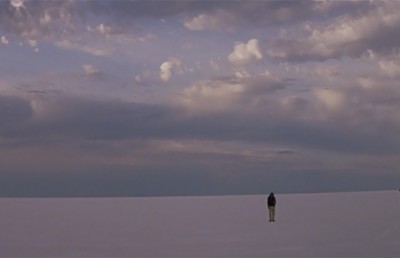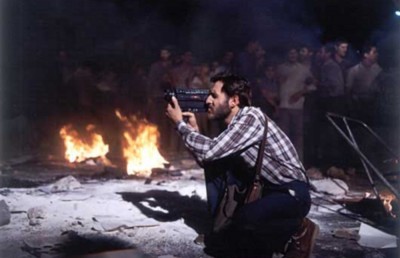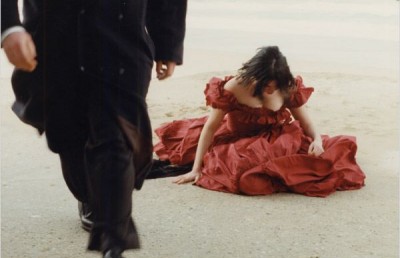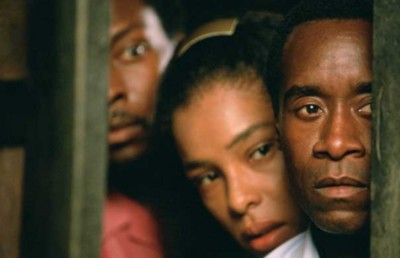Close-Up X 2
Iranian Reflexivity

Iran is, along with Korea and India, one of the movie-mad capitals of the world. By this I mean that its film culture is marked by an over-all obsessive interest in film that spreads from filmmakers to film viewers, from popular cinema to art cinema, from buffish literature to theory. This obsession is evident in the treatment of reflexivity found in works of nearly every important contemporary Iranian director, from Abbas Kiarostami, to Mohsen Makhmalbaf, to Jafar Panahi. Kiarostami’s wonderful “trilogy” (Where is My Friend’s Home 1987, And the Life Goes On…1992, and Under the Olive Trees 1994) coyly plays with notions of narrative, reflexivity and fiction/documentary. His Close-Up (1990), described by Werner Herzog as “the greatest documentary on filmmaking I have ever seen,” tells of a fascinating “fait divers” which in itself says much about Iran’s mad-love affair with cinema. The film recounts the true story of a frustrated 42 year-old film buff, Ali Sabzian, who dupes a middle-class family into thinking that he is director Mohsen Makhmalbaf scouting for a potential family to cast in his next film. Sabzian, while never menacing, exploits the family’s gullibility and ingratiates himself into their household. As if that isn’t reflexive enough, there is a documentary film which chronicles the duplicitous would-be actor Ali Szabian, Close-Up Long Shot (Mahmoud Chokrollahi, Moslem Mansouri, 1996, France, 44 min., video). Unlike its progenitor Close-Up, Close-Up Long Shot does not play with questions of reflexivity or fiction/non-fiction, but is a straightforward “talking head” examination of the phenomenon behind a man obsessed with cinema beyond all rational measures.
Though formally uninteresting, the video manages to slowly draw us into Sabzian’s psyche with its minimalist palette (no music, no camera movements), and probing long takes of Ali Szabian. What starts off as an outsider’s look in (interviews with co-workers, neighbors) ends up being a probing, at times Freudian self-examination of a troubled man whose inability to separate film from reality is as much symptom of a psychic problem as a symptom of how important cinema is to the average Iranian. Szabian, formally uneducated and accused as such by some of the earlier interviewees, comes across as being extremely perceptive, intelligent and very clever concerning notions of social culpability. Sabzian underscores the irony in his situation by noting how people around him, from Abbas Kiarostami, to the media represented in Close-Up, to the family, are all willing partners in his predicament. He willingly casts himself as a “victim of cinema,” not unlike the many serial killers who blame their crimes on the media’s glorification of murder and the representation of murder in films and television.
In the film’s final minutes Szabian pours his heart out to/for the camera. He says that his irrational act is a testament to his love for cinema: “I spent the best days of my childhood in the dark…perhaps the adult in me is tired, but it listens to the child….I am physically small, but spiritually big.” His fanatical religious-like devotion to the cinema seems to have eclipsed family, friendship, and work. As I’ve noted in a previous essay,
The video raises some interesting questions concerning the nature of obsession and the delicate, unformed line between acceptable and non-acceptable obsession. His sister may be exaggerating when she says that 80% of people in Iran are like him, but the Azi Sabzian phenomenon is surely representative of a cinema craze that is an integral part of Iranian culture.1
Reverse Angle (Maani Petgar, 1996-97, Iran, 33 min., video) is a reflexive documentary on the filmmaking process that exhibits what would be considered a more acceptable form of cinema obsession: cinematic allusion and intertextuality. Director Maani Petgar takes his video camera to the set of an unnamed British/Australian co-production. The images, taken mainly at dusk, are in themselves not interesting. The camera usually remains at a distance, panning left to right quietly capturing the hustle and bustle of a film set. The distance of the camera to the set suggests that director Petgar was given a free license to film but with as little interruption or interference as possible. Crew members scurry about: carpenters, gaffers, and special effects people. The film’s meaning, however, suggested in its already reflexive title, comes about through a discourse between the image and the soundtrack. Petgar layers the soundtrack with sound bites from selected auteurist and modernist films and directors. Most of the sound bites (there are a few film clips too) express lofty aesthetic or philosophical ideals on cinema, which contrast to the mundane, pragmatic reality (nuts and bolts) of the filmmaking process that the camera records: cinema-making versus cinema-thinking. For example, the first sound clip we hear is an Andrei Tarkovsky quote (on film and time) taken from the documentary Directed by Tarkovsky, (Michal Leszczylowski, 1988) while the camera slowly pans past crew members mulling about in-between camera set-ups.
The selection of clips (visual and aural) reveals much about Petgar’s own taste, but also of a broader Iranian interest in art cinema. Many of the clips are taken from classics of reflexive, intertextual cinema: Stardust Memories, The State of Things, Sunset Boulevard, Burden of Dreams, Tokyo-ga. The first film clips we see are from, in order, Blow-up, Je Vous Salue Marie, and Paris, Texas. The choice and order is not arbitrary. They denote the chronology of the three (arguably) most important European modernist narrative filmmakers: Michelangelo Antonioni, Jean-Luc Godard and Wim Wenders. Sound clips are taken from such other modernist classics as Shadows of Our Forgotten Ancestors, Wild Strawberries, Padre Padrone, and Simon of the Desert. The voices of Federico Fellini and Werner Herzog are also heard.
The shadow of the European Art film is also evident in the short fiction video by director Iraj Karimi, Unspoken Words (who has since directed his first feature film, Going By Az kenar-e ham migozarim in 2003). When Unspoken Words (Iraj Karimi, 1996, Iran, 35 min.) played at The Festival of New Film and Media the director introduced it as an attempt to capture the emotion of “mourning.” Stylistically we can see the influence of Kryzstof Kieslowski in Karimi’s attempt to fuse (in his words) “realism with a touch of metaphysics.” Again, we see the influence of modernism/art cinema on Iranian filmmaking. The story of Unspoken Words is about a husband and wife who are not on speaking terms and communicate through their son, Sami. The father and son are both killed in a car crash, leaving familial emotions unresolved. The father and son return as wandering ghosts, moving silently in a trance-like state, while the wife mourns. In the end a mysterious letter from the husband helps to alleviate some of the unresolved emotion and pain. Though there are a few nice touches (preponderance of subjective point-of-view shots after the double death to emphasize the wife’s isolation; use of widescreen ratio), the video relies on too many cliché effects to achieve its maudlin emotions (unstated love, unresolved emotions). For example, a (too quick) cut to the son’s ball bouncing down the street to stand-in for the car crash/death. Fritz Lang used this type of synecdochic cut better back in 1930 in M (using a balloon rather than a ball)! All in all, Close-Up, Close-Up Long Shot, Reverse Angle, and Unspoken Words, while all several years old, reveal a sophisticated awareness of cinematic history and unique tropes of reflexivity which continue to characterize current Iranian films and film culture. For example, the title echo between Close-Up and Close-Up Long Shot is recalled in Kiarostami’s own recent two videos, Ten (2002) and 10 on Ten (2004). Salaam cinema.2
ENDNOTES
1 Donato Totaro. “Reflexivity in Recent Iranian Cinema: The Case of Mohsen Makhmalbaf,”
Asian Cinema Vol. 11, No. 2 (Fall/Winter 2000): 46.
2 The films Close-Up Long Shot, Reverse Angle and Unspoken Words were viewed during the 1997 Festival of New Film and New Media. As far as I know, neither is available on video or DVD, at least in North America. Addendum: As of 2003 Close-up, Long Shot has become available on DVD, from the France label MK2, as a bonus alongside the feature film Salaam Cinema.














